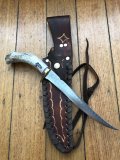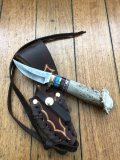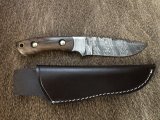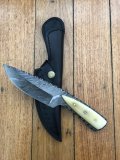Damascus Knife: Japanese Made 45 Layer Damascus BushCraft Knife with Red Stag Antler Handle and Custom Keith Fludder Sheath
- Blade Steel Type : 45 Layers Damascus Hammered Stainless Steel, AUS10 Alloy Core
- Keith Fludder Custom Made Black Leather Knife Sheath
- Handle Material : Red Deer Antler
- Knife Type :Straight fixed Blade Hunting Knife
- Blade Length : 12cm
- Total Length : 24.5cm
- Blade Edge : Double edged (50/50 balanced, available for use by both left and right-hand)
- Brand NEW unused.
- Made in JAPAN
*** Some facts about Damascus Steel ***:
Pattern welding or Damascening, the traditional method for making decorative patterns on forged products, originated some hundred years before Christ.
The process was first seen in Persia around 500 BC and used to produce welded blades. The laminate composition of a Damascus Steel blade is attained by alternating layers of soft malleable wrought iron and a hardenable and temperable steel with a high carbon content. The steel portion of the blade gives it strength and the ability to hold a fine edge, while the iron provides elasticity so it won't break when struck. The layering of the steel patterns revealed by etching the surface has been refined into a decorative art.
The term Damascus Steel itself comes from the European Crusades who came in contact with these superior weapons at the trading city of Damascus. When the technology spread across Asia into India it was called Wootz. The Japanese surpassed all other regions with their refinement of lamination techniques. Today the pattern-welding technique is used for the most exclusive knives and swords. The material choice is limited to steel types which are hot workable enough and possible to weld by forging. Stainless grades or tool steels are very difficult to work in this respect.
Two popular components with blade smiths these days, are 1095 and 15N20, with good reason. On their own, each steel would make a good choice for blades and the contrast between the two steels is excellent. The 1095, although a simple steel, has just the right amount of carbon to make a superior blade and the addition of manganese serves to aid the hardening process and makes it etch quite dark. The 15N20 has nearly as much carbon and has about 2.5% nickel content added to make the steel very tough. The second benefit of nickel is that it withstands the etch very well for a good contrast with its darker counterpart. Another benefit of these steels is that they can be differentially hardened for an extremely tough blade while still retaining a superior edge.

















